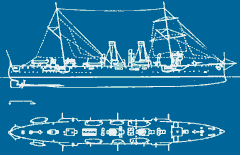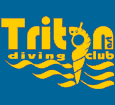The story about "Zenta"
There
are not many ships near the Montenegrin coast that make
the heart of a diver pump faster. One for shore is the Austro-Hungarian
cruiser. Because of its unknown position open sea
and a great depth, "Zenta" was unseen for many years. The
dream of the more extreme diving population came throw for
the "Triton" diving team. Because of the great depth and
the complexity of the project, every team member was assigned
with a task. The team member where:
|
Zivojin Stojankic
-PADI instructor Equipment and navigation
Aleksandar
Ljustina -PADI instructor camera and lights
Vlatko Taleski -PADI divemaster deep dives and logistics
Mirko Bevenja -PPADI divemaster deep dives and deco calculations
Uros Filipovic -PADI divemaster backup
Tanja Novakovic -Padi rescue diver backup .
|
 |
A historical achievement
There was much
hearsay about the famous Austro-Hungarian cruiser "Zenta",
divers diving the wrack, and talking about it. Maybe not
the first team to dive this wrack "Triton" is for shore
the first to bring us a film and photographs from the ship.
This is the first time that the cruiser has been filmed,
and share his secret with us .
Historical background
"Zenta" was build in Pula and launched on the 18th of August 1897.
Zenta was one of three ships of the same class, Aspern and Sigetvar being the other two. The ship had 312 sailors and officers 312 (according to some sources 350). "Zenta" was 96.8m long, 11.7m wide, had a draft of 4.4 m and deplacement of 2543 tone. Through 8 coal burners two vertical triple engines producing 8560 hp drove it. As an addition Zenta had 585 square meters of sails. Its maximum speed was 21.8 knots.
Zenta had only a light armor, on the deck, bridge and guns. With his armament of 8 Skoda 120mm canons, two 47 mm Hotchkiss canons, 8 light cannons, four machine guns and two torpedo tubes of 530mm Zenta was relatively good armed.
The blockade of the south Adriatic was of most importance for the Austro-Hungarians, in this way disabling the allays, the Frances in the first place, to deliver war material through Montenegro to Serbia. At this moment the importance of the harbor in Boka Kotorska was much grater then that in Pula or Sibenik. The task to block the southern part of the Adriatic sea fell on two light cruisers, tree destroyers and four torpedo boats. Zenta was one of these ships. In the early morning on the 16th of August 1914 Zenta left the port of Tivat in the escort of the destroyer Ulan, two hours later following the war ship Monarch and two other destroyers. About 8 a.m. the scouts from Ulan spotted enemy ships coming closer from the Otrant. Those were the armored battle ships of the Inflexible type under the command of admiral Troubridge. Monarch, at that moment 5 miles offshore between cape Volujica and Mendra also se smoke trails but from the northwest. That was the France fleet consisting of 17 ships of the Danton type under the command of admiral Lapeyre. The Monarh immediately turned around and sailed back to the entrance of Boka Kotorska, app. 1 mile from the cape Ostro waiting for Zenta with his cannons ready to fire. The cannons from the Monarch had to be the protection for the Zenta and Ulan, which received the command to immediately come back. After receiving this command Ulan sailed full speed towards Boka Kotorska hoping to arrive before the enemy approaches enough to fire. Zenta was not that lucky. With his old engines built back in 1897. cud not escapes the enemies. About 9 a.m. Zenta was surrounded. The last attempt was to get closer to the shore so the sailors can rescue themselves if the ship sinks. The France ships came closer with a speed of 20 knots, giving light signals to Zenta to surrender. Captain Pachner from the Zenta gives the order to rise the flag of the Austro-Hungarian monarhy. After that the fire on Zenta was opened. The machine room, the main battery, the steam lines were hit. Zenta also fired but hit buy enemy grantees he was unable to maneuver and become an easy target. The platoons from the France battle ship Courbet hit the front boiler room and the ship begins to sink. Despite of that the fire dos not stop. At this moment Zenta was 4 miles Southwest from the town of Petrovac. Ten minutes later the beetle was over. First the bow came out of the water, and than the whole ship went under finding his last shelter on the seabed in 75 m. After sinking the ship the enemy just turned around and sailed away leaving the wounded sailors to die in the cold water. About 3 p.m. the wounded sailors were rescued by Montenegrin fishers. 129 sailors and officers survived. They were cured and take to prison in Cetinje. In January 1916 all were released and sent home.
87 years later ...
Once again the effort and commitment showed results. The divers from Triton tried to locate and film the ship back in 1998. One of the actors Zivojin Stojankic remembers how it all started: The project went through its steps from the may of 2000 when we first dived the ships a few times. With the help of information's get from the locals we made the first dive at may the 6th and find a wrack thinking it was Zenta. To show respect to the dead sailors we put a bottle of vine on the deck and bind a club flag on the deck. But this was also a moment of big disappointment to us realizing that this wrack was not Zenta. On the next dive we were more fortune and find and positively identify the Wrack of Zenta. This time we tied a club flag to his mast. We found the same flag a year later grown over with alges..." says Zivojin.
The dark blue surface of the water showed mercy to the divers of Triton once again. It was the 16th of August 2001. A day before we searched for hours with out success only 150m south of the right location. At this moment we did not realize the de destiny was to film the ship on the 16th of August, the weary day, only 87 years later that it's being sunken.
We reached the diving location early that morning. The team routinely prepared for the dive. It was of the grate importance to follow a predetermined time schedule. The decompression equipment, oxygen and backup tanks had been deployed on the deco station. The first deep divers Mirko Bevenja put on the heavy equipment give an OK sign and descended in the cold dark blue water. The second deep diver Vlatko Taleski was already equipped and in the water, waiting the right moment do descend. He will take over the camera from Mirko and keep on with the filming. The next divers Zivojin Stojankic and Aleksandar Ljustina will descend as a par. The backup divers Uros and Tanja are on position. After 40 min the first diver is already executing the predetermined shallower deco stops on pure oxygen while the others starting to arrive on the 12 9 and 6 m deco stops. The safety divers are assisting on the deco stops, providing rehidration liquids and taking over cameras and other unnecessary equipment.
We chouse this kind of diving (solo diving) to use the limited bottom time in a best way.
Such dives are unforgettable for every diver. Vladimir Taleski responsible for the logistic tells his story: We first saw Zenta from a depth of 55 m. On previous dives we ware able to se the wrack from a depth as shallow as 45 m. The wrack lies on the muddy seabed in a depth of 73 m. The bow is turned to the 300 degree course, the same direction as at the day the ship was destroyed. We had a slight current on the bottom that made the visibility even worse. The deck is at app. 63 m and has many holes from platoons and the fire that was burning. A weary frightening moment was when I saw many fishers net the entangled at the wrack. I have a filing, if there were no nets the wrack would look like still sailing and defying his enemies. During the dive we heard many underwater detonations from illegal fishers, but this is a different story..." says Vlatko Taleski.
What's next?
On that August day in 1914 while the sailors from Zenta floated hopelessly on the water the Montenegrian authority, although an enemy, allowed the fishers from Castel Lastva (today's Petrovac) to save the sailors. The Montenegrin showed compassion and saved their enemies from the certain death. As a gesture of gratitude the survivors from Zenta build a church on a little island in front of Pertovac an named it Holy Sunday. Thy also gave as a present a sliver box with their names on it to the doctor who heal them.
In the earthquake in 1979 the small church was destroyed.
After 87 years the film of Zenta has been presented to the public, pointing out that diving on this location must be undertaken with respect for the death sailors, and according to local law.
A
translation from
"Svet ronjenja":
Janez Kranjc
|

